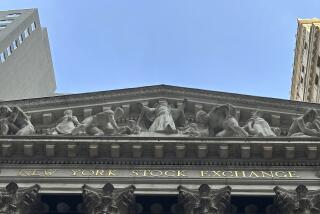MARKET BEAT / TOM PETRUNO : In This Episode, Our Investor Falls for a Bulldozer
If you can think of the stock market as a soap opera, you can understand the most important aspect of whatâs going on there this year.
Wall Street has been in love with Stock Group A for many years. But suddenly, Group A has bitten Wall Street, causing it severe emotional pain. This affair is on the rocks. Now along comes Stock Group B, saying all the right things. Wall Street isnât quite sure it wants to leave A for B--but, bit by bit, we all can figure how this story line will go.
In Group A are the major consumer stocks of the â80s, like Wal-Mart, Philip Morris and Merck. In Group B: industrial names like bulldozer king Caterpillar, machine tool producer Cincinnati Milacron and Dow Chemical, among others.
The big story of 1993 has been one sad report after another of slowing sales and earnings growth among the consumer leaders. Meanwhile, the fortunes of many of the industrial companies increasingly appear on the rise.
Thursday, for example, Caterpillar and Dow Chemical both reported first-quarter earnings that were far above Wall Streetâs expectations. So did Kennametal, which makes basic metal-bending tools for such fields as highway construction and mining. The reports sent the companiesâ stocks soaring, lifting other industrial names as well.
Caterpillar alone zoomed $5.25 to $67.50, its highest level since mid-1990. And all because the company earned a mere 34 cents a share in the first quarter instead of just breaking even, as Wall Street had expected.
If Catâs stock gain seems outlandish, thatâs an integral part of the plot in this soap opera. As Wall Street shifts from Group A to Group B, it finds there are far fewer industrial companies than there are consumer companies. So each member of Group B stands to get much more attention--and faster--than it might otherwise deserve.
A couple of numbers to illustrate: Even though Philip Morris stock has plunged this year as its cigarette pricing power has waned, the stock market still values the company at $42.8 billion. Thatâs its market capitalization, or stock price times number of shares outstanding.
In contrast, the total market value of all eight major machinery companies in the Standard & Poorâs diversified-machinery group--including Caterpillar, Deere, Ingersoll-Rand and other well-known names--is just $22.9 billion.
Mike Wolf, a portfolio manager for IDS Advisory Corp. in Minneapolis, notes that the shrunken capitalization of the industrials reflects how âmost of these companies went through hell the last 10 years.â Their markets dried up for a long time, foreign competition boomed, credit was tougher to get. Most of the companies were forced to slash costs and dramatically improve their efficiency.
Now the payoff is that many U.S. industrial firms can reap enormous profits from even a slight pickup in demand. Thatâs what happened in the first quarter for Caterpillar and Kennametal, among others. And thatâs the trend Wall Street expects to play out over the next few years, as the global economy heals bit by bit.
As far as the stocks go, think of this situation in terms of a funnel: A lot of money is coming out of highly valued but fading stocks such as Philip Morris, Merck and Wal-Mart. And that cash now is fighting its way into a much tinier space, as represented by the relatively small valuations of the industrial stocks. The result can be explosive upward pressure on the industrialsâ share prices.
Unfortunately, many of the former consumer-stock dollars constitute so-called hot money, which stays with a stock only so long as itâs rising. Some of the same industrials injected with that money earlier this year now are seeing the downside as those traders exit for sexier stories. Thursday, for example, diesel engine maker Cummins Engine plunged, for no apparent reason.
âWhen this âmomentumâ game stops, it can stop violently,â warns Bill Stromberg, a money manager at T. Rowe Price Associates in Baltimore. He warns investors to look carefully at how much the industrials already have risen. Indeed, even factoring in high 1994 earnings expectations, many of the stocks now trade at above-average price-to-earnings ratios.
Tobias Levkovich, who tracks the machinery companies for Smith Barney, Harris Upham & Co. in New York, doesnât argue that the industrials are richly priced overall. But conservatively, he says, Caterpillarâs peak earnings power in the mid-1990s should be $8 a share. If heâs right, and you can afford to buy and hold, this $67.50 stock is going a lot higher over the next few years.
The point is, investors may return to the industrials in fits and starts through 1993 and 1994--but the important thing is that they are indeed returning, because the companiesâ fundamentals are good and getting better. If youâre a stock investor, you canât afford to sit out a market trend thatâs this powerful. Mutual fund investors in particular should pay heed: If your funds donât own some of these industrial names, diversifying into one or two that do would be a smart move now.
Industrial Stocks: Another Leap Forward
Many industrial stocks surged Thursday on surprisingly good first-quarter earnings. Hereâs a look at the stocksâ P-Es (price-to-earnings ratios) based on estimated 1994 earnings per share, and their current dividend yields.
Thurs. P-E on Div. Stock price â94 EPS yld. Caterpillar 67 1/2, +5 1/4 16 0.9% Cin. Milacron 26 1/8, + 3/8 17 1.4% Cummins Engine 89 7/8, -6 1/4 8 0.2% Deere 58 1/4, +2 1/4 17 3.4% Dow Chemical 56, +3 1/8 17 4.6% Ingersoll-Rand 33, +2 1/8 15 2.1% Kennametal 34 3/4, +2 7/8 18 3.3% Monsanto 55 1/4, +1 1/8 12 4.1% Nucor 83 1/8, -3 3/8 18 0.4% Tenneco 46 5/8, - 1/4 13 3.4% S&P; 500 439.46, -4.2 16 2.8%
Source: Zacks Investment Research (analystsâ consensus earnings estimates); all trade on NYSE
More to Read
Inside the business of entertainment
The Wide Shot brings you news, analysis and insights on everything from streaming wars to production â and what it all means for the future.
You may occasionally receive promotional content from the Los Angeles Times.







